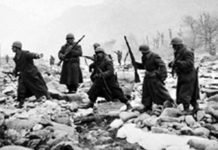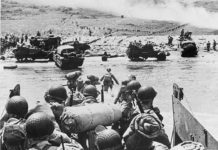The Battle of Britain began in the summer of 1940, right after the collapse of France. It lasted through the end of October when the Blitz began. The battle was fought over whether the Germans would gain air supremacy over England. Had they achieved this, Operation Sea-Lion, the planned invasion of England, would have followed.
What many today fail to realize is that this was a very close-run thing. In the spring of 1940, British cryptologists broke the German Luftwaffe code, otherwise known as Enigma. The impact of this discovery on the ensuing Battle of Britain and the remainder of World War II was immense. In many ways, it helped to tip the scales of victory in the Allies favor.
In 1974, when Ultra was first de-classified by the British Government, F.W. Winterbotham published his The Ultra Secret. In it, he argued that Ultra was the only thing that saved the RAF from defeat at the hands of the Luftwaffe. [1] On the opposite side of the spectrum, F.H. Hinsley wrote in his British Intelligence in the Second World War, the Official History:
That Germany lost the battle and was forced to abandon the attempt to land in England – this outcome, contrasting with her successes so far owed much to the difficulty of the German undertaking and perhaps still more to the tenacity of the British resistance. It owes less to the fact that British intelligence was at last beginning to improve. [2]
The complete contrast between the two positions aptly demonstrates the difficulty of answering the question possed above definitively. It can be reasonably assumed, however, that the answer lies somewhere between these two positions. It is this “grey area” that I will now explore.
The Germans did a significant amount of their bombing during the night, particularly toward the end of the conflict and during the Blitz. For obvious reasons, this posed navigational difficulties when they tried to find targets, especially non-London ones. For this reason, a radio based navigation system known as Knickebein was developed. [3]
The Knickebein system consisted of two intercepting beams, one which used dots and another which used dashes (for use in Morse Coade). These beams were used by German pilots to find their bombing targets. The Knickebein navigation system provided remarkable accuracy, usually within 400 feet of the intended target. [4] The Germans had 12 Knickebein radio beam transmitters located throughout the occupied Low Countries and France. [5]
On June 12, 1940, Bletchey Park intercepted an Enigma message. All it said was: “Cleve’s Knickebein is beamed at position 53 degrees 24 minutes north and 1 degree west.” [6] But this is what R.V. Jones, the Assistant Director for Scientific Intelligence at the Air Ministry, was searching for. [7] He began working on a plan to thwart the Knickebein system. The plan that was developed entailed jamming the Knicekbein beams, by sending out dashes on the same frequency as the beam. This induced a great loss of confidence and morale in the Luftwaffe ranks, and led to less damage occurring. [8]
One further thing should be said about the Knickebein beams. Luftwaffe Command regularly sent out Knickebein information via the Enigma machine. By the summer and fall of 1940, the Luftwaffe cipher was being promptly deciphered by Bletchey Park. Through the Knickebein beams, the British knew where the German targets were. Thus it was possible to take measures to prevent the bombing of these targets, or to minimize damage caused to them. In one historian’s eyes, this fact alone was the decisive reason for Germany’s loss of the Battle of Britain. [9]
One of the more important engagements during the Battle of Britain was “Adlerstag,” or “Eagle Day.” On August 8, 1940, Hermann Göring, the head of the Luftwaffe, sent battle instructions to his three Air Fleets which were promptly picked up on Ultra. The Battle instructions were as follows: “Operation Adler. Within a short period of time you will wipe the British Air Force from the Sky. Heil Hitler.” [10 Because of bad weather, the massive raids were postponed. When the raids finally happened a week later, the British were ready.
The air battle that took place on August 13 and 14, 1940, was, in many ways, the turning point of the Battle of Britain. As the Luftwaffe Air Fleets proceeded to follow Göring’s order, RAF planes went up in significant numbers and in the right places. They were guided by radar and by Ultra, as Göring and the Air Fleets planned strategy and signaled through Enigma during the battle. [11] By using Ultra, Sir Hugh Dowding (the Commander of the RAF) was able to carefully apportion his resources and defeat the German onslaught. As a result, the Luftwaffe suffered three times as many losses as the RAF during the course of the battle. [12]
The information that Dowding received through Ultra clearly enabled him to achieve victory. As far as its immediate contribution to victory in the Battle of Britain, Ronald Lewin asserts that this information was the daytime equivalent to that received about the Knickebein beams. It was instrumental in bringing British victory in the Battle of Britain. [13]
By the end of September the Germans began to believe that victory in the Battle of Britain was not likely, at least not in 1940. The Germans shifted their targets to population centers, and postponed Operation Sea-Lion. By mid-October, the English knew that Hitler had canceled the invasion through an important Enigma signal that announced the disbanding of the invasion staff. [14]
Based on this information and other encrypts that supplemented and verified it, Winston Churchill decided to divert tanks and supplies fro England to Field-Marshal Wavell in Egypt. With these tanks and supplies, Wavell halted the ongoing Italian offensive and then launched an offensive into Libya which almost reached Tripoli (this became the major reason for Hitler’s decision to send Erwin Rommel to North Africa in Feb. 1941). [15] Had Churchill thought that England was still in danger of being invaded, he would not have sent tanks and supplies to another front. [16]
Compared with other campaigns later in the war, the information that Ultra provided during the Battle of Britain was less substantial. It did, however, play a significant role. Without Ultra, Dowding would not have been able to plan as he did before and during Adlerstag. It is clear what the outcome of the rest of the Battle of Britain would have been had the RAF lost that battle. The number of civilian casualties during the Blitz would have also been much higher had it not been for the discovery of the Knickebein beams. Thus, it can be concluded that the RAF would have had a much more difficult struggle against the Luftwaffe had it not been for Ultra. As it was, the margin was narrow!!
- Footnotes:[1] F. W. Winterbotham, The Ultra Secret , (NY: Harper & Row, Publishers, 1974), p. 187.
- [2] F.H. Hinsley, British Intelligence in the Second World War (Brit. Intell.), v. 1, (London: Her Majesty’s Stationary Office (HMSO), 1979), p. 164.
- [3] Richard Hough and Denis Richards, The Battle of Britain, 2nd ed., (NY: W.W. Norton, 1990), p. 268.
- [4] Hinsley, p. 325.
- [5] Ibid., p. 555.
- [6] Ronald Lewin, Ultra Goes To War, (NY: McGraw-Hill Book Company, 1978), p. 76.
- [7] Ibid.
- [8] Ibid., pp. 97-8.
- [9] Wladyslaw Kozaczuk, Enigma, (Frederick, MD: University Publications of America, 1984), p. 187.
- [10] Hough and Richards, p. 154.
- [11] Lewin, p. 87.
- [12] Ibid., p. 86.
- [13] Ibid.
- [14] Peter Calvocoressi, Top Secret Ultra, (Hong Kong, China: Macmillan Publishing Co., Inc., 1980), p. 72.
- [15] Gerhard L. Weinberg, A World At Arms, 2nd ed., (NY: Cambridge University Press, 1995), pp. 210-11, 215.
- [16] Calvocoressi, pp. 72-73.








